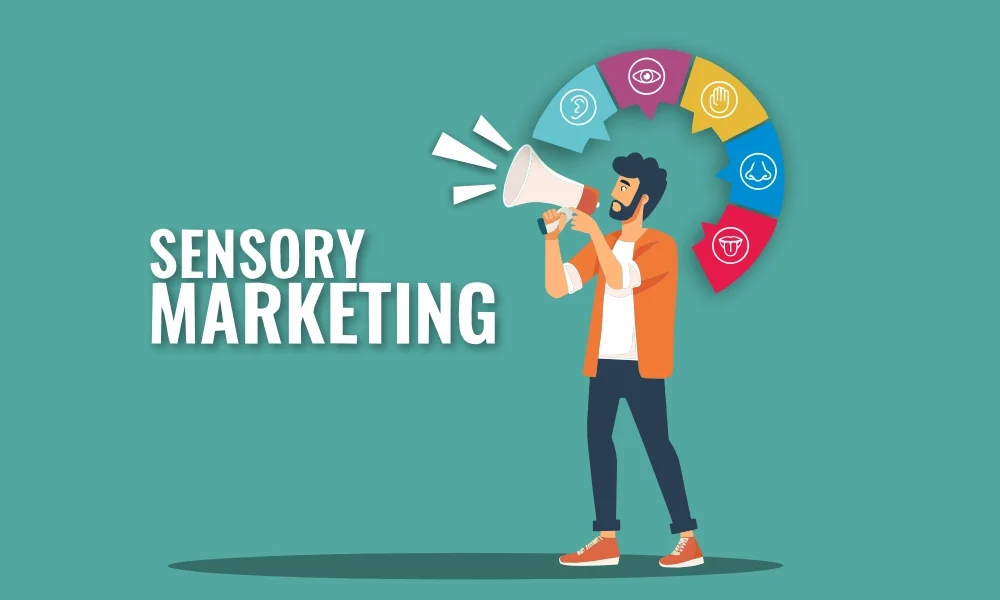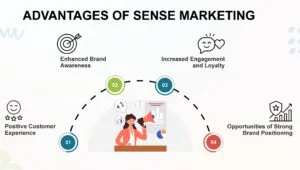Have you ever experienced a situation when a coffee advertisement seems so enticing that you feel like having a sip of it right there? You can suddenly smell the coffee through the ad itself! You may not know, but brands deliberately adopt such an approach to attract the audience, which is also known as sense or sensory marketing.
Sense marketing is an efficient technique that companies often integrate to interact with their potential audience through the five human senses. Sources reflect that over 90% of consumers prefer to revisit a store if they like its visuals, music, and fragrance.
But are such marketing initiatives still relevant and effective in contemporary times? Let's find out...
What is Sensory Marketing?
Sense-based or Sensory Marketing refers to an approach that uses five human senses- sight, sound, smell, touch, and taste for marketing purposes. Experts describe it as one of the most effective marketing strategies that not only contributes to attracting larger audiences but also drives a high conversion rate. Such approaches seem increasingly appealing to the audience, assisting companies in understanding consumer behavior and often inspiring consumers to make buying decisions.
Product-based businesses often adopt this strategy widely. Companies of all sizes can incorporate such tactics for better outcomes. The core elements used are strong visuals, aroma, and sound that contribute to activating human senses. All these components contribute to users' understanding for recalling or recognizing a particular brand or product.
Organizations also adopt such strategies for impactful branding. For example, tech giant Google's logo reflects the colors red, yellow, green, and blue. Even if the company name is not written somewhere, people immediately recall Google whenever they see these colors together.
How Does Sensory Marketing Work?
Sense marketing utilizes methods that assess five human senses to identify the daily experiences of individuals form different perceptions. Following the assessment, this strategy uses the extracted insights to shape how individuals feel about a company. Statistically, sense-based marketing contributes to better decision-making. Let us understand the usage of each sense and how they work-
Sight:
Visual or sight-based efforts are the most impactful methods of sensory advertising. It uses colors, figures, shapes, and visuals to impact user psychology, creating brand identity. Alongside that, companies also use this method to evoke different emotions, integrating diverse elements in their advertisements. For example, utilizing red denotes excitement and urgency; on the other hand, blue is used to show stability and trust.
Sound:
The element of sound is applied in different ways, such as jingles and signature tunes of brands. This approach helps audiences to recall a brand or product immediately after they hear a specific sound. It commonly involves sound effects that a product usually makes, like munching on crispy fries or zipping a backpack.
Smell:
This approach of sense marketing targets the human sense of smell while helping individuals recall brands, shops, and products through fragrance only. Accordingly, companies and retail stores prefer to use specific fragrances to influence their customers through smell.
Touch:
Understanding the texture of a product plays a significant role at times while sustaining customer loyalty and brand recognition. This approach is commonly used by clothing brands. The sense of touch enables individuals to verify the comfort level and quality of a product.
Taste:
Integrated mostly into food and beverage products, taste elements in sensory marketing contribute to prompting cravings and hunger within individuals. Taste is often integrated with other senses, like visuals and smell, for better outcomes.
For example, Fever-Tree's product sampling event in 2022, where the company initiated a face-to-face experience, distributing their product samples to the broader audience.
What Advantages Does Sense Marketing Offer?
Sensory marketing can be highly beneficial for businesses, offering opportunities for creating personal connections with consumers.
Enhanced Brand Awareness:
There are multiple occasions when we recall a brand by certain logo colors, taglines, and music. So, while adopting sense marketing, brands often intend to leave a mark in the consumers' minds, increasing brand awareness.
Increased Engagement and Loyalty:
Including methods like sight, smell, and sound in marketing campaigns helps companies to engage with their consumers at a personal level. It also assists consumers in remembering that particular brand for a long time, adding to brand loyalty.
For instance, if any brand adds strong visuals to their ad campaign, it attracts audiences in an engaging way. Furthermore, such components help audiences to remember the advertisement and the brand for a long time.
Positive Customer Experience:
While the senses of the audience are aroused by pleasing visuals, smell, sound, touch, and taste, the customer experience is often positive. Alongside that, such aspects also assist in sustaining a positive customer perspective.
Opportunities of Strong Brand Positioning:
Sense-based marketing commonly assists companies in highlighting their uniqueness and specialty. Such an approach assists companies in positioning their brand more appropriately in the market.
How Brands are Using Sense Marketing:
Businesses commonly integrate single or multiple senses for better outcomes. Let us understand the applications of sensory marketing through case studies across industries.
Apple:
Apple majorly targets the visual sense through its brand positioning and marketing campaigns. Their stores are always in white and have minimal aesthetics. Alongside that, the slick design of their products and the logo seem visually attractive to the audience. All these aspects allow consumers to easily remember and recall the brand.
Warby Parker:
Warby Parker, an eyewear company, uses visual and touch to comprehend and complement consumer behavior. The firm offers the feature of virtual try-on, with which audiences can see how different frames will look on them.
Alongside that, the material and design Warby Parker describes through their advertisements add warmth to consumers' understanding.
Mastercard:
While implementing sensory marketing, Mastercard includes the elements of sound and visuals. Every time individuals make a transaction, a sonic sound rings. Additionally, their logo includes red and yellow circles, two bold colors. All these elements help consumers immediately recall the company whenever they hear that particular sound or see those colors.
Starbucks:
Starbucks is known for its visually appealing logo. However, the company also targets the sense of smell to attract consumers. Each Starbucks store is mostly covered with the strong smell of coffee beans to offer the customers a warm feeling that they should get through a sip of good coffee.
Is Sense Marketing Still Effective?
Many marketing practitioners question the impact of traditional marketing strategies like sense marketing in the technological era. As a result, several companies look to integrate only trending digital marketing techniques. However, such orthodox tactics work nothing but magic when it comes to winning the trust and loyalty of consumers. It is one of the most effective tactics for offline brand positioning.
As businesses and their products have become more consumer-centric, brands often prioritize understanding consumer behavior and enhancing customer experience (CX). Sensory marketing allows companies to boost CX with impactful engagement. Establishing real interactions, providing warmth, and depicting how a product is actually going to look, smell, feel, sound, and taste are among the core characteristics of sense marketing, which digital marketing methods often lack.
Therefore, companies looking for effective marketing strategies can choose to combine digital methods and traditional strategies, like sensory marketing. Such an approach will allow businesses to take advantage of both online and offline channels, achieving remarkable marketing outcomes.
Over To You!
In contemporary times, consumers don't only need quality products but also anticipate unique experiences. Sensory marketing is prominent in offering exceptional experiences to consumers, arousing their senses and emotions. Alongside that, it also supports businesses in assessing consumer behavior.
Companies aiming to boost their brand awareness alongside establishing trust and loyalty among consumers must adopt sensible marketing.
Stay updated with the latest marketing and tech trends with KnowledgeNile!
Recommended For You:
5 Ways Artificial Intelligence Helps in Personalized Marketing






